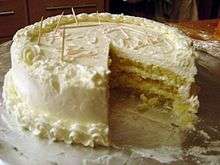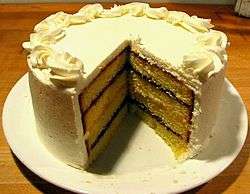Genoise
|
Genoise sheet and rounds | |
| Alternative names | Genoese cake, Genovese cake |
|---|---|
| Type | Sponge cake |
| Place of origin | Italy |
| Region or state | Genoa |
| Main ingredients | Flour, sugar, eggs |
| Variations | Chocolate genoise |
|
| |

A genoise (/ʒeɪˈnwɑːz/, /ʒəˈnwɑːz/, /dʒeɪˈnwɑːz/, or /dʒɛˈnwɑːz/; French pronunciation: [ʒenwaz]; Genoese cake or Genovese cake; rarely spelled "génoise" in English)[1][2][3][4] is an Italian sponge cake named after the city of Genoa and associated with Italian and French cuisine. Instead of using chemical leavening, air is suspended in the batter during mixing to provide volume
Genoise should not be confused with pain de Gênes ("Genoa bread") which is made from almond paste, but it is similar to pan di Spagna ("Spanish bread"), another Italian sponge cake.[5][6]
It is a whole-egg cake, unlike some other sponge cakes for which yolks and whites are beaten separately. The eggs, and sometimes extra yolks, are beaten with sugar and heated at the same time, using a bain-marie or flame, to a stage known to patissiers as "ribbon stage". A genoise is generally a fairly lean cake, getting most of its fat from egg yolks, but some recipes also add in melted butter before baking.
Use and preparation
Genoise is a basic building block of much French pâtisserie and is used for making several different types of cake. The batter usually is baked to form a thin sheet. An 1884 cookbook gives a simple recipe for a genoise:[7]
Work together briskly in a basin half a pound of flour, half a pound of sugar, and four eggs: after five minutes' good stirring, add a quarter of a pound of melted butter. Butter a square baking sheet, spread the paste upon it, and bake it in a moderate oven until it turns a golden yellow.
When finished baking, the sheet is rolled while still warm (to make jelly rolls or bûches de Noël), or cut and stacked into multiple layers or line a mold to be filled with a frozen dessert. A variety of fillings are used, such as jelly, chocolate, fruit, pastry cream, and whipped cream. The genoise can be piped in strips to make ladyfingers or into molds to make madeleines. It is the base for Jaffa Cakes.

The cake is notable for its elastic and somewhat dry texture and is sometimes soaked with flavored syrups or liqueurs and often served with a buttercream frosting. The popular tiramisu cake may be made with ladyfingers or a genoise sheet.
A chocolate genoise can be made by substituting cocoa powder for some of the flour, and is sometimes used as a substitute for the richer cake used in the standard Sacher torte recipe.
See also
References
| Wikimedia Commons has media related to Génoise. |
- ↑ American Heritage Dictionary
- ↑ Oxford English Dictionary
- ↑ Collins Dictionary
- ↑ Merriam-Webster Dictionary
- ↑ Carole Bloom, The Essential Baker: The Comprehensive Guide to Baking Page 601 2007 "American sponge cake traditionally has no fat and has a light, airy, delicate texture. It is a close relative of the classic French génoise cake, which is made with a small amount of butter. "
- ↑ Amy Brown Understanding Food: Principles and Preparation - Page 480 2010 "Unshortened cakes are also known as sponge or foam cakes and include angel food, sponge, meringue, dacquoise, génoise, and roulade. The term sponge in food preparation is frequently used to denote foods made with beaten egg whites."
- ↑ Arthur Robert Kenney-Herbert (1884). Sweet Dishes. A Little Treatise on Confectionery and Entremets Sucrés. p. 242.
- Child, Julia, Julia's Kitchen Wisdom. New York, Knopf, 2000, ISBN 0-375-41151-8.
- Child, Julia and Simone Beck, Mastering the Art of French Cooking, volume 2. New York, Knopf, 1970.
- Editors of Cook's Illustrated, Baking Illustrated. Brookline, MA, America's Test Kitchen, 2004, ISBN 0-936184-75-2.
- Editors of Domus magazine, The Silver Spoon (US English translation). New York/London, Phaidon Press, 2005, ISBN 0-7148-4531-0.
- Roden, Claudia, The Book of Jewish Food. New York, Knopf, 1997, ISBN 0-394-53258-9
